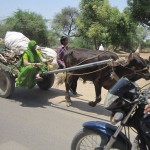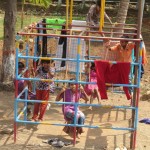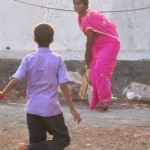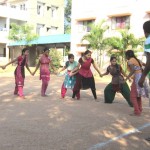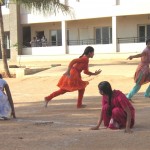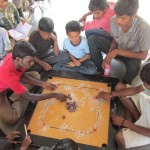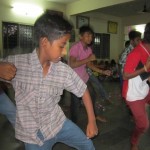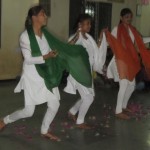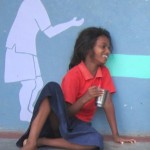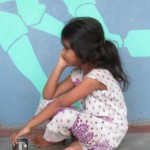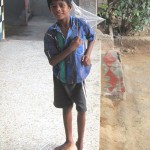Robin Cappuccino is currently visiting all of the Child Haven homes and programs overseas. He has been kind enough to share a glimpse of his journey with us.
Greetings from Child Haven International’s Home for 48 formerly destitute children in Savarsai, India. Savarsai is a small village, several hours drive from the Mumbai airport, where our flight lands. Ajit, our usual driver, picks us up in his 4WD Toyota, for the stimulating journey to the Home. The dotted lines between lanes appear to be for decoration purposes only. Often 5 or 6 rows of traffic, including motorized rickshaws, motorcycles, bicycles, the occasional ox-cart, massive 2-wheeled carts pulled by sinewy men, buses and trucks, are packed into what the less adventurous back home might utilize for only 2. Of course here there are many more people going many more places in a great multitude of conveyances. There also is less personal space in general, and that certainly applies to a very intimate sharing of roadways. This is most dramatically experienced in the amount of distance considered necessary to pass vehicles as well as the required vision of the road ahead for that to be deemed a good idea. Fortunately oncoming traffic generally is familiar with this approach to road-sharing and are experienced and adept at quickly riding off onto the shoulder usually without slowing down as the need may arise. All of this is accomplished, and is perhaps only possible, with the use of maximal and near constant hornage. The application of this auditory information and feed-back cannot not be over-estimated in this process. It stands to reason that the use of an additional sense would be advisable if not required in such closely careening quarters. Avoidance of accident reports in the local paper tends to contribute to a more relaxed trip. Fortunately, Ajit is a skillful practitioner, and we make it to the Home once again. It may also help that there is a workshop producing plaster statues of the Hindu God Ganesh, the remover of obstacles, right next to the Home.
Bonniema’s arrival is greeted with great excitement as carrom and cricket games are temporarily abandoned while we shake 48 outstretched hands. The little kids delight in shaking hands repeatedly especially when one shakes 2 or 3 hands simultaneously. We are introduced to several new children including one little boy whose mother, we are later told, brought him to the Home after she had been abandoned by her husband who threw her into the fire before he left. She was still covered in scars. Her five-year-old son had somehow figured out how to support them both selling ice-cream in the street while she convalesced. His cheerful presence gave no indication of his having had this challenging set of experiences.
One of the other kids, Indika, age 7, is quick to show us how well she has learned to climb the metal poles supporting the porch roof. She has learned to hold herself up using just her feet. This skill was doubtless perfected as she and other kids climbed and scoured the top-most branches of our mango trees for ripening fruit. It is mango season in India, and there is no worry about mangoes from our trees over-ripening and going to waste as they are constantly monitored, by dozens of keen eyes and harvested at the first hint of ripeness. Tiny Indika’s dexterity and fearlessness in tree-climbing is near legendary. The bananas ripening near the new library room reach a greater degree of ripeness as they are not quite as extraordinary a treat. The same is true of the jackfruit protruding tumor-like from the trunk of a neighbor’s tree.
It being school vacation, the kids busy themselves with all manner of play in the yard. A great deal of enjoyment is found with an abandoned garden hose, which gets cut up and fashioned into swings for the jungle-gym. Hirakani, a care-giver for the girls, ramps up her status with everyone, by hitting a cricket ball out of the yard when she steps up to bat. The night-watchman and soya-milk maker, Icha’s, 2-year-old daughter, Karyshma, is thrilled to be given pen and paper to begin her writing career.
A highlight of the visit for me is a play put on by some of the older kids about saving girl children. Foeticide of female fetuses remains a wide-spread plague. While the use of ultrasound and subsequent operations for this purpose is strictly illegal, the practice persists. In Mumbai, the ratio of girls to boys is 874 to 1,000. An estimated 15 million girls were simply not born in India over the last decade. The play presents a family discussion on the impending birth of a girl child. At the conclusion of the play, Divya, age 16, gives an impassioned soliloquy in Marathi demanding to know why girl children are not wanted. As translated to me she states, “Now, women are doctors, lawyers, engineers. We can do anything men can do. Plus we take better care of our parents. There is no reason for girls not to be born!” In any language it was clearly a passionate declaration. Judging by the spontaneous applause, it was an articulate and meaningful one as well. Purveyors of injustice take note – a new generation of truth-speakers is well on their way.
Until next time,
Robin Cappuccino for CHI
Stay tuned for another ‘glimpse of the journey’ as Robin continues his travels through the CHI homes in India, Nepal, Bangladesh, and Tibet.
